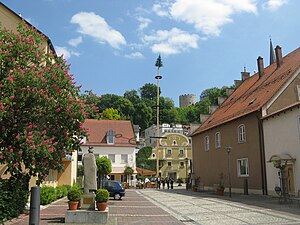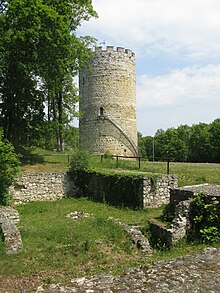Abbach Castle
| Abbach Castle | ||
|---|---|---|
|
Abbach Castle from the market square |
||
| Creation time : | first mentioned May 6, 973 | |
| Castle type : | Hilltop castle | |
| Conservation status: | Keep, remains of the wall | |
| Construction: | Quarry stone, humpback cuboid | |
| Place: | Bad Abbach | |
| Geographical location | 48 ° 55 '59.4 " N , 12 ° 2' 54.5" E | |
|
|
||
The castle Abbach (of the particularly the so-called. Heinrich storm , known locally as the dungeon called, deserves attention) are the remains of a hilltop castle in the market Bad Abbach in the Lower Bavarian district of Kelheim of Bavaria (Schlossberg).
history
It is assumed that the Bajuvars had already built a fortification on the remains of a Roman fort here, but there is no evidence of this. In documents that will Burg Ahabach first mentioned on May 6 973rd
Abbach Castle is associated with the assumption that Emperor Heinrich II was born here . However, no historical source evidence can be found for this claim. On the other hand, it is correct that this emperor donated this place to the diocese of Bamberg , which he founded, on November 1st, 1007 , whereby Bishop Otto made the Abbach fief, which was settled after the death of the Bamberg fiefdom holder Friedrich von Pettendorf, available for the convent founded by him in 1107 . A court day for the Counts of Abensberg was held here in 1183, although it is unclear what these claims were based on. The bailiwick of the monastery was owned by the Counts von Bogen and after their extinction in 1242 the Wittelsbach family . Abbach Castle was taken over by the Wittelsbachers around 1200 (possibly not until 1224); at that time the Wittelsbachers had also succeeded in bringing the Danube tariff at Abbach under their control. Allegedly, the castle was destroyed by the Bamberg bishop or the abbot ofprüfunging when he was handed over to the monastery. Duke Ludwig I had this rebuilt in 1224 and compensated the monastery with Königswiesen near Regensburg and Matting; the agreement reached over the castle or the castle hill was on 22 November 1231 by Pope Gregory X confirmed. As a result, the duke significantly expanded his property in the Abbach office (the customs revenue was essential for this). Abbach Castle was the starting point for the creation of a judicial district Abbach, subdivided into the court brands Schierling and Sandsbach . Presumably the castle should also serve as a counterweight to the expansion efforts of the Bishop of Regensburg .
In 1297 Abbach was burned down in the course of a feud between the Bavarian dukes Otto and Stephan and the citizens of Regensburg. Then the lock, which now only served as the caretaker's apartment , was made on a smaller scale. Possibly Count Ulrich von Abensberg owned Abbach - presumably as a pledge - from 1331. In the second half of the 14th century the pledging of Abbach increased. On February 24, 1347, Emperor Ludwig the Bavarian relocated his Feste Abbach as security for a promised reparation to the city of Regensburg. A day later, Heinrich, the old Gumppenberger , announced that Emperor Ludwig had entrusted him with the Abbach fortress together with Thomas von Freuntzperch and Arnold von Mässenhausen. On July 13, 1431, Duke Wilhelm of Bavaria pledged Abbach Castle with market, court and all accessories to Michael von Eglofstein for the purchase of Neueglofsheim Castle. From January 19, 1474, Leonhard Saller zu Meillenhofen had a lapel opposite Duke Albrecht , who had given him the castle, court, box, toll and escort at Abbach as a pledge. On January 7, 1486, Hans Paulsdorfer the Younger was given the same reverse to Kurn opposite Duke Albrecht.
In 1564 it was found that the curtain wall and the castle were neglected . A Salbuch 1586 contains the following statement: The castle did the same a large courtyard in the middle stands a round tower that had no roof for many years, as well as a deep water well , but which does not always give water. The strong ring walls had partly collapsed, one could no longer go around everywhere. The house is not big; the stables are below the ground, with two vaulted rooms, a kitchen and a room. On the floor above there is a children's parlor, another parlor and a chamber with wooden walls. At the top is a grain box.
During the Thirty Years' War in 1632 and 1634, the local citizens, court and other surrounding subjects fled with their belongings to Abbach Castle and defended it. In 1648, however, they no longer dared to oppose the violence; Abbach's citizens had to surrender and pay high war taxes. In 1705, during the War of the Spanish Succession, Abbach was handed over to the Austrians without a fight. Between 1740 and 1745 Abbach was pillaged several times as a result of the War of the Austrian Succession .
With the abandonment of the maintenance office, which had meanwhile been built outside the castle, in 1803, the demolition work on the castle buildings began; by 1832 almost all buildings except for the keep had been removed. Most of the castle wall was also torn down, although instructions had been given to keep it six feet high. In April 1945, the Heinrichsturm was hit by bombs, because an observation post of the German Wehrmacht had been on it. The masonry was then only sparsely repaired. On August 31, 1979, part of the outer masonry collapsed. In the early 1980s, the tower, which is now accessible by a steel staircase above the old high entrance, was renovated (completed on July 6, 1985).

- Abbach Castle
Abbach Castle (Heinrichsturm) then and now
The engraving by Michael Wening from 1721 shows a castle area surrounded by a wall on the castle hill of Bad Abbach, from which the keep , the so-called Heinrichsturm, protrudes. A house can also be seen in the castle area, presumably the caretaker's residence at that time. A church can be seen outside the castle, but protected by a wall. The Abbach market spreads out below the Schlossberg.
The keep of Abbach Castle is still preserved today. It is a round tower made of irregular ashlar masonry with rough embossing from around 1220/1230. The 27 meter high late Romanesque tower has a four and a half meter thick masonry made of quarry stone , which is clad on the outside by humpback blocks made of Bad Abbach green sandstone and lime sandstone. The crenellated crown of the tower was not put on until the second half of the 19th century. At a height of 10 m there is a round arched high entrance , which can be reached by means of a wooden ladder. In front of the opening, two corbels protrude from the wall; there was probably a wide step attached here. Inside the tower there are two octagonal chambers with vaulted helmets, one above the other. Remains of the castle wall have also been preserved.
literature
- Alfons Kraus: Bad Abbach. Our historical, cultural and social heritage. Publishing house Ph. CW Schmidt, Neustadt an der Aisch 2012. ISBN 978-3-87707-839-6 .
- Günther Pölsterl: Mallersdorf. The Kirchberg regional court, the Eggmühl and Abbach nursing courts. (= Historical Atlas of Bavaria, part of Altbayern booklet 53), pp. 75-107. Commission for Bavarian History, Verlag Michael Lassleben, Munich 1979, ISBN 3-7696-9923-8 .
- Peter Schmid: 1000 years of Abbach. Emperor Heinrich II and Abbach. Lecture on October 27, 2007 on the 1000 year old first documentary mention of Ababch's donation to the diocese of Bamberg. Bad Abbach: 2008, Heimat- und Kulturverein Bad Abbach e. V.
- Werner Sturm: Abbach Castle and Heinrichsturm. In commemorative publication on the completion of the renovation of the Heinrichsturm (pp. 2–22). Heimatverein Bad Abbach, 1985.
Individual evidence
- ^ History of the health resort Bad Abbach.
- ↑ Werner Sturm, 1985, p. 22.
Web links
- Heinrichsturm in the Kelheim district
- Abbach Castle ruins (Heinrichsburg) on burgenreich.de
- Abbach castle ruins on castles in Bavaria
- Abbach castle ruins on burgseite.de
- History of the health resort Bad Abbach in the Danube Valley









